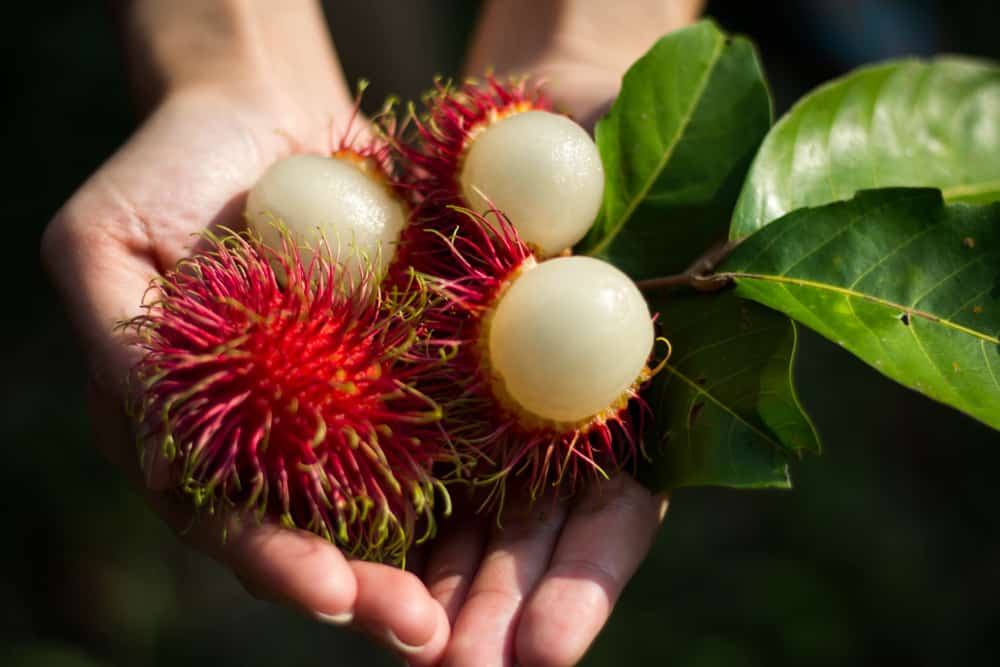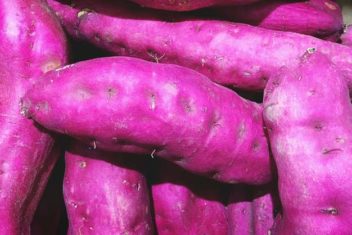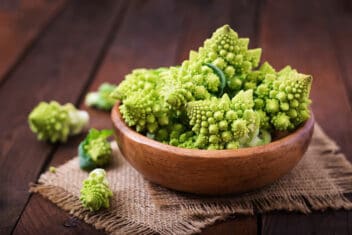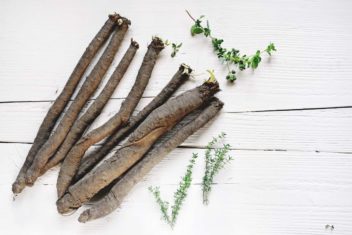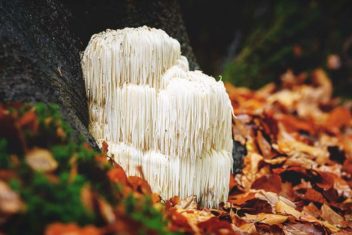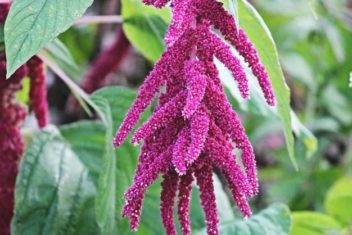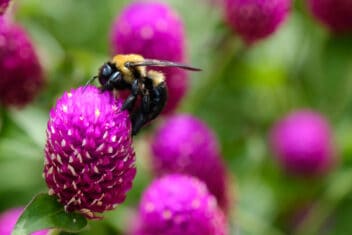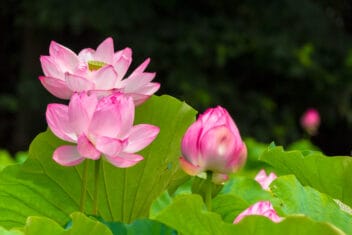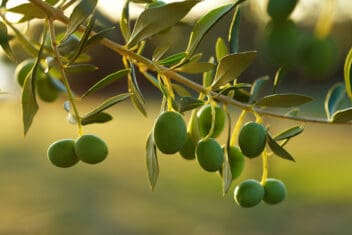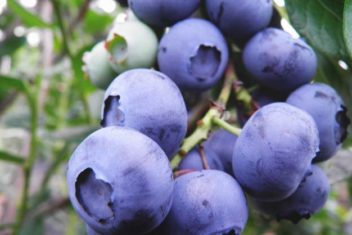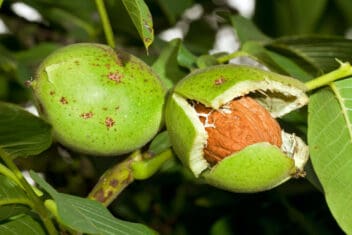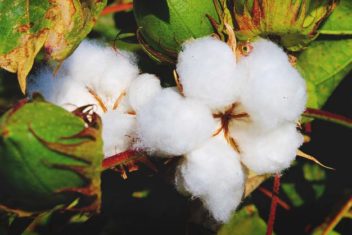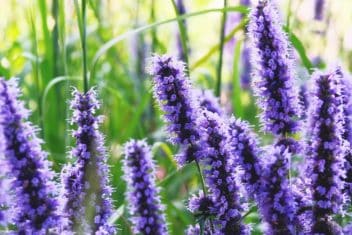One of the great things about gardening is the sheer amount of choice you have for planting. As long as you live in the right kind of environment, you can try growing less common but fabulous heat-loving fruits like rambutan. It’s a decision you will definitely not regret once you bite into this sublime treat.
Although rambutan is not a well-known fruit in the US, if you like lychee, you will love the taste of this exceptional fruit. They’re becoming more popular to grow in many warmer regions. Ready to join the rambutan movement?
What is Rambutan?
Rambutan (Nephelium lappaceum) is a member of the soapstone family and is native to Malaysia. It’s an evergreen that can grow up to 80 feet tall and is cultivated in countries like India, Thailand, Burma, and Sri Lanka where they are as common as apples are in western countries.
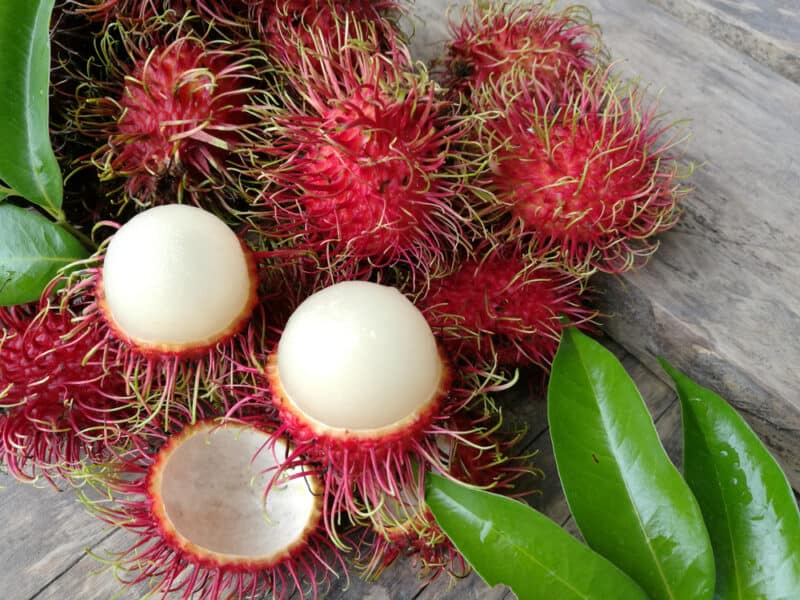
High in vitamin C, iron, and antioxidants, the sweet and sometimes slightly sour flavor will surprise you as much as the appearance of the fruit itself.
“Rambut” is a Malay word meaning “hairy,” which certainly describes the fruit’s appearance. Inside is a sweet white flesh that makes for a tasty snack. Don’t worry, though. While the exterior may look spiny, the spikes are actually soft and the skin is easy to peel away.
Best Varieties of Rambutan
Rambutans come in a variety of colors, primarily red or yellow-skinned. Red varieties generally ripen first and are medium-sized. The yellow varieties usually ripen later and are a little smaller. Red rambutan flesh is a little drier than yellow-skinned fruits, which are juicier. Both have white flesh.
The stones at the center of the flesh can be free or not, and the stones have an outer coat between it and the flesh called a testa.
There are over 200 varieties, so check what’s available around you and if there are more than one, choose the type with the characteristics you prefer. Here are some of the most popular.
Queen Zaida
This is a medium-sized fruit with dark red skin and a white, sweet fleshy inside. Moderate yields.
Princes Caroline
This cultivar yields heavy harvests of dark red fruit with thick flesh. The seeds are particularly small.
Quezon
‘Quezon’ produces small to medium-sized fruits with a sweet and slightly sour taste. Moderate yields.
Quirino
Yellowish skin with reddish, pink spines, this cultivar has extremely sweet and juicy fruits. The tree bears in clusters of about 80 fruits per group.
Santo Tomas
The fruits of ‘Santo Tomas’ have yellow, pink skin with thick flesh and a small seed. This tree produces moderate yields.
Ponderosa Ferreras
The fruits of this cultivar are red-skinned with large, soft spines. Inside is very thick flesh that is extremely sweet. Yields moderate amounts of large fruits.
Governor Infantada
This cultivar is slightly sour and acidic, with thick flesh. The fruits don’t store well and should be eaten within a week of harvest. Produces moderate harvest yields.
Jitlee
‘Jitlee’ or ‘Jit Lee’ produces reliably high yields of crimson red fruits. The stones in this cultivar are free. This is a smaller cultivar and needs just ten feet of spacing.
Binjai
This cultivar has orange-red fruits with a clinging testa. The tree is medium in size and can be planted just ten feet apart from others of its size.
Silengkeng
Also spelled seelenkeng, this tree has more of a weeping growth habit. The fruit is slightly sour. This is a popular cultivar in Hawai’i. The testa is moderately clinging.
Kaimana
This is a popular variety in Hawai’i because it flowers reliably and doesn’t suffer from the pollination problems that others have.
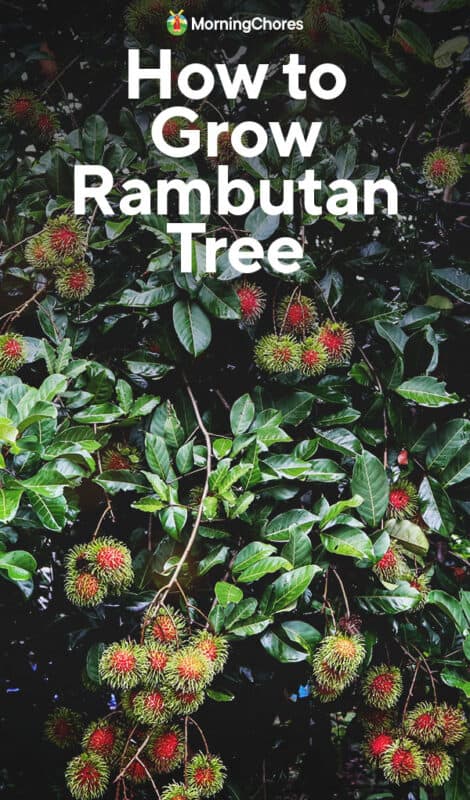
How to Plant Rambutan
Rambutans need a tropical or semi-tropical environment to grow successfully. They will do very well when temperatures are consistently around 71-86ºF. A couple of days under 50ºF will definitely cause the demise of this tree, which loves heat and humidity.
USDA Zones 10 and above are ideal, but if you live in a warm area outside of these zones, you could try your rambutans in movable containers and bring them in when the weather cools.
These trees can grow anywhere from sea level to 1,800 feet, but not higher.
Rambutans need deep, loamy soil that drains well and doesn’t allow the roots to sit in water. A pH of 5.5 to 6.5 is perfect and they won’t do well in soil that is too acidic or alkaline.
This is a sun lover, so plant in full sun. If you live in a hot area, a little afternoon shade will be beneficial, especially for the first few years.
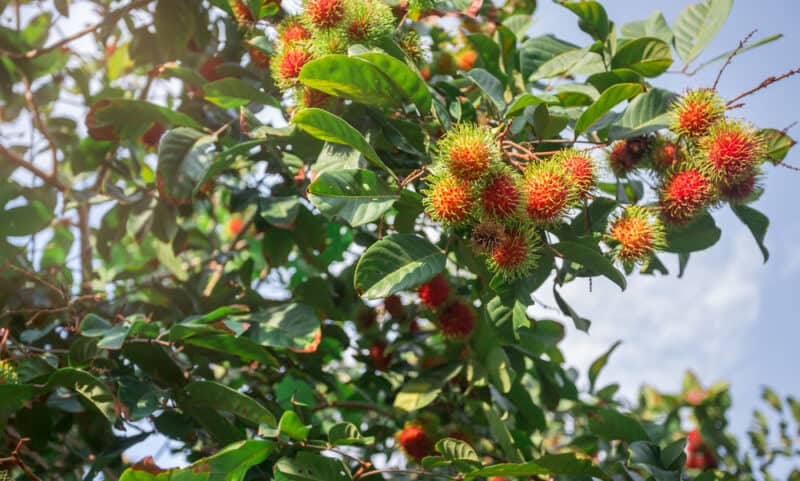
Space trees around 40 feet apart as they can grow up to 80 feet high with a wide canopy.
Make sure you plant away from sidewalks and trails as this is a heavy fruiting tree. It’s inevitable many of the fruit will fall to the ground and they are slippery when smashed, which could cause someone to lose their footing, not to mention the mess they make.
Propagating Rambutan
The easiest, and most likely-to-succeed method of propagating rambutan is by way of seed. It’s easy because the seed is big and if you follow a couple of rules, you should see successful germination.
- Remove the seed from a ripe, healthy rambutan.
- Wash gently, but thoroughly. You need to remove all the flesh and juice as this inhibits germination.
- Use a seed raising mix, or for better results, try a soilless mixture that rambutan seeds love. Have an equal mixture of four quarts of coconut coir and vermiculite. Add a tablespoon of superphosphate and 2 tablespoons of limestone.
- Place this in a small pot with good sized drainage holes.
- Place the seed horizontally into the mixture with the flat side of the seed down.
- Cover with moistened mixture and place in a warm, sunny area.
- Keep the mixture moist and germination should take place in nine to 25 days.
- If you have a seed starting mat, 75ºF is perfect.
A rambutan tree grown in this way will take up to five years to bear fruit, so decide whether you want this method, or if buying a tree suits you better.
You can also propagate these trees through bud grafting.
Grafted trees, whether purchased or grafted at home, are reliable and produce fruit quickly.
Caring for Rambutan
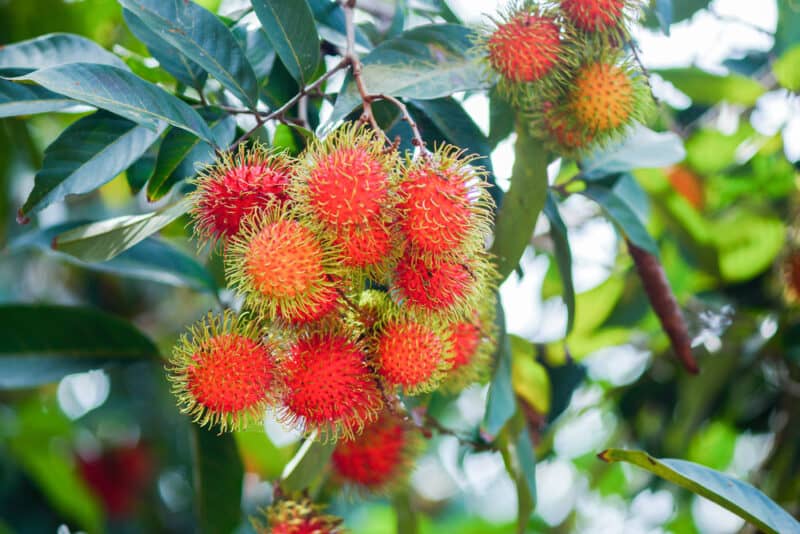
Provide rambutan with a fertilizer specifically for fruit trees. Apply the correct amount stated by the manufacturer just before flowering and again after harvest.
Water well all year round if you have dry winters. A rambutan tree needs at least an inch of water per week, so if it doesn’t rain, make sure to keep the soil well-watered.
Rambutan will tolerate drought, but only for a short period.
If you have your plant in a pot, water until it starts to drain from the bottom. Water again when the soil feels dry to the touch.
Prune rambutan for shape and to remove damaged or dead branches. Once the tree is fully grown, it will require minimal pruning.
Rambutans growing in Hawai’i suffer from low pollination, which results in fewer and deformed fruits. To remedy this, you’ll need to do your best to encourage pollinators to come and visit your trees. Flowering occurs after water stress in the spring or summer.
Companion Planting for Growing Rambutans
Plant any fruit tree that loves tropical heat near your rambutans. In fact, growing other fruit trees near your rambutans will help increase the number of pollinators that come around.
- Dragonfruit
- Guava
- Soursop
- Jackfruit
- Starfruit
- Citrus trees
- Avocado
- Papaya
- Lychee
- Longan
Common Problems and Solutions for Growing Rambutans
Rambutans have a few pests and diseases that trouble them. These vary by location.
Mealybugs
These piercing and sucking bugs can do real damage to rambutan, especially if their numbers grow too big.
The best way to identify mealybugs is by the damage they cause. You’ll see stunted plant growth, crinkled and dry leaves, and wilting for no apparent reason.
Mealybugs particularly like new growth so you may see little pitted holes where they feed. Dark, moldy leaves where sooty mold forms will attract ants who love the sweet treat.
To treat a mealybug infestation, I prefer the green method. Take two cups of water and two teaspoons of dish soap in a spray bottle. Spray liberally on the rambutan plant as many times as you need to. This only works on small trees, however. For larger trees, you’ll need to bring out the big guns.
Purchase lacewings, which are natural predators, and spray the tree once a week with a high-pressure sprayer to knock the bugs loose. Prune away any heavily infested branches.
Red Banded Thrips
Originally from West Indies, this bug (Selenothrips rubrocinctus) can invade many heat-loving crops, especially in places like Florida. Called red-banded due to the red stripe across the middle of the bug during its immature stages, females can lay up to 50 eggs on leaves and fruit.
Small pale spots appear on leaves before the whole plant becomes silvery. Badly infected plants may appear to be bleached.
The thrips will be on the undersides of leaves. They are often controlled by natural predators like spiders and lacewings, so purchase or encourage these natural predators.
If they become too high in number, the rambutan may suffer from stress. Use neem oil regularly, or try organic pyrethrum as a knockdown remedy.
Corky Bark
This fungal disease caused by the pathogen Dolabra nepheliae is an easy one to identify and is common in high rainfall areas with high humidity. At first, you’ll see irregular patches on the bark of the trunk and lateral branches. As the fungus progresses, the lesions become corky in appearance.
Over time the bark cracks and raised cankers form. If there is a lot of rainfall, the cankers can absorb moisture, causing the rotting of the wood.
Harvest yield will be reduced while the tree battles with the fungus.
Prevention is the only defense. Make sure you clean all of your tools, especially if you are pruning multiple trees. If corky bark has been present before, don’t plant your rambutan in that area. Remove any infected branches and burn them. ‘Gula Batu’ has some resistance to the disease.
Oriental Fruit Fly
The maggots of oriental fruit fly (Bactrocera dorsalis) tunnel into the fruit of many trees including rambutan. A single female can lay up to a thousand eggs in her lifetime.
Emerging as larvae, they drop out of the fruit and burrow into the soil for around 12 days. Ten days later, an adult emerges and they are very strong flyers, known to travel up to 30 miles in search of food and a place to lay eggs.
This is a serious pest and states have eradication programs, so see what is required in your area.
Powdery Mildew
High humidity or rainfall during summer may cause powdery mildew to form and spread. This will cause the fruit to drop prematurely.
This is a common disease that is easily identified. See our article here on powdery mildew for more information.
Harvesting and Using Rambutan
Harvest time varies by location. In Hawai’i, late summer to early winter is typical. Harvest the fruit when the hairs are bright and evenly colored. The fruit should have some give and feel nice and plump when you squeeze it.
Rambutans are usually eaten fresh, especially since they take up a lot of room, although they will last up to two weeks in the refrigerator in a plastic bag. They can also be used in jams, baking, ice creams, and sorbets.
Despite their appearance, the spikes are soft and the skin is peeled away easily. Just be careful when exposing the flesh as they can be very slippery.
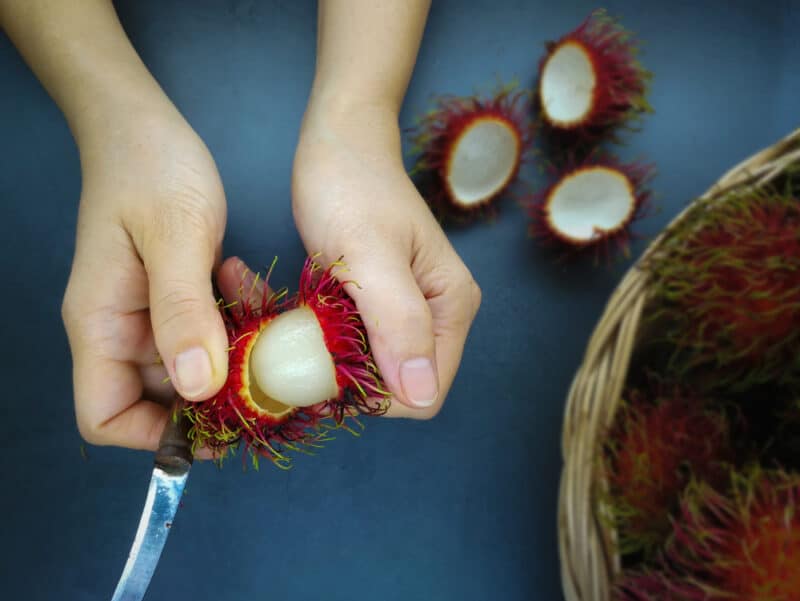
To open a rambutan, gently score the skin using a knife. Then, pull the two halves apart, leaving the flesh inside intact. You can then cut the flesh in half and remove the stone inside.
